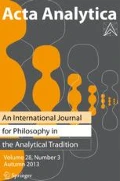Abstract
Causal theories of reference in the philosophy of language and philosophy of science have suggested that it could resolve lingering worries about incommensurability between theoretical claims in different paradigms, to borrow Kuhn’s terms. If we co-refer throughout different paradigms, then the problems of incommensurability are greatly diminished, according to causal theorists. I argue that assuring ourselves of that sort of constancy of reference will require comparable sorts of cross-paradigm affinities, and thus provides us with no special relief on this problem. Suggestions on how to think about rigid designation across paradigms are included.
Similar content being viewed by others
Notes
One can glean much of what I am saying here from a dictionary entry, but a more thorough treatment of the subject is offered in Sachs (2002). It is also worth remembering that coroners remain political officials, not medical doctors; medical examiners perform autopsies, not coroners, despite common confusion.
My thanks to an anonymous reviewer for reminding me of this point.
Such incommensurabilities could be synchronic as well as diachronic during transition periods, e.g., the sorts of discrepancies between Stahlian and early post-Stahlian chemists described later in this paper.
My work on this section in particular was helped by conversations with Mary Domski and Terry Winant. Any deficiencies are of course my problem, not theirs.
Churchland (1981) suggests this emphasis on functional properties as the definitive feature of alchemical approaches to chemistry, though he does so in the course of deriding any model that would do so as unscientific for failing to reduce to more purely physical theories. This serves as an analogy in deriding functionalism in the philosophy of mind, a cornerstone of his early work on eliminativism.
My thanks to an anonymous reviewer for suggesting the second example here.
References
Bensaude-Vincent, B., & Stangers, I. (1996). A history of chemistry. D. VanDam (Trans.). Cambridge, MA: Harvard University Press.
Churchland, P. (1981). Eliminativism and the propositional attitudes. Journal of Philosophy, 78(2), 67–90.
Devitt, M., & Sterelny, K. (1999). Language and reality: An introduction to philosophy of language (2nd edn.). Cambridge, MA: MIT Press.
Feyerabend, P. (1962). Explanation, reduction, and empiricism. In: H. Feigl, & G. Maxwell (eds.), Minnesota studies in the philosophy of science, vol. 3 (pp. 28–97). Boston: D. Reidel Publishing Company.
Gough, J. (1988). Lavoisier and the fulfillment of the Stahlian revolution. Osiris, 4, 15–33.
Hacking, I. (1982). Experimentation and scientific realism. Philosophical Topics, 13, 71–87.
Kripke, S. (1980). Naming and necessity. Cambridge, MA: Harvard University Press.
Kuhn, T. (1990). Dubbing and redubbing: The vulnerability of rigid designation. In: W. Savage, (ed.), Minnesota studies in the philosophy of science, vol. 14 (pp. 298–318). Minneapolis: University of Minnesota Press.
Kuhn, T. (1996a). The structure of scientific revolutions (3rd edn.). Chicago: University of Chicago Press.
Kuhn, T. (1996b). Possible worlds in the history of science. In: J. Conant, & J. Haugeland (eds.), The road since structure (pp. 58–89). Chicago: University of Chicago Press.
McGinn, C. (1982). The structure of content. In: A. Woodfield (ed.), Thought and object (pp. 207–258). Oxford: Oxford University Press.
Newman, W. & Principe, L. (2002). Alchemy tried in the fire: Starkey, Boyle and the fate of Helmontian chemistry. Chicago: University of Chicago Press.
Putnam, H. (1975). The meaning of ‘meaning’. In mind, language and reality: Philosophical papers, vol. 2 (pp. 215–272). New York: Cambridge University Press.
Sachs, J. (2002). Time of death: The story of forensic science and the search for death’s stopwatch. London: William Heinemann Pub.
Soames, S. (2002). Beyond rigidity: The unfinished semantic agenda of naming and necessity. Oxford: Oxford University Press.
Stanford, P., & Kitcher, P. (2000). Refining the causal theory of reference for natural kind terms. Philosophical Studies, 97, 99–129.
Westfall, R. (1977). The construction of modern science: Mechanisms and mechanics. New York: Cambridge University Press.
Wolf, M. (2006). Rigid designation and anaphoric theories of reference. Philosophical Studies, 130, 351–375.
Author information
Authors and Affiliations
Corresponding author
Rights and permissions
About this article
Cite this article
Wolf, M.P. Reference and Incommensurability: What Rigid Designation Won’t Get You. Acta Anal 22, 207–222 (2007). https://doi.org/10.1007/s12136-007-0009-6
Received:
Revised:
Accepted:
Published:
Issue Date:
DOI: https://doi.org/10.1007/s12136-007-0009-6



